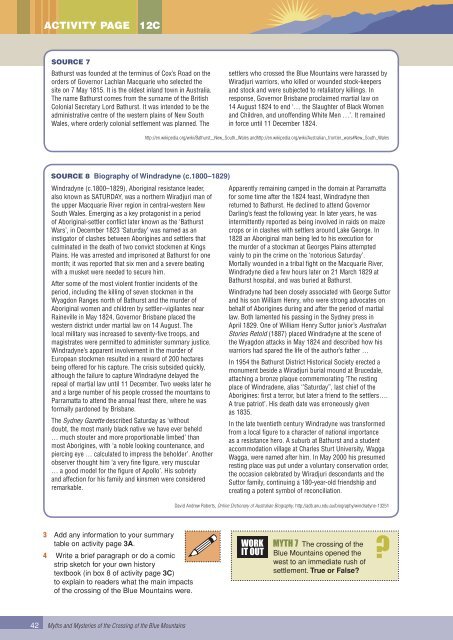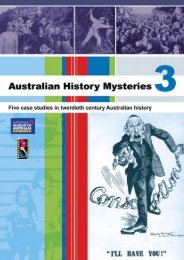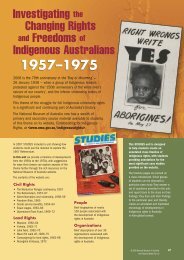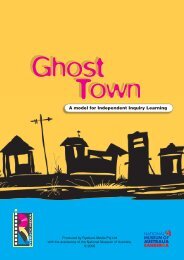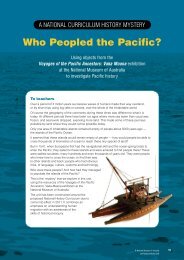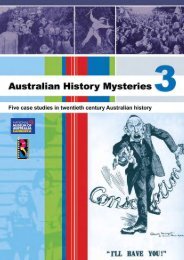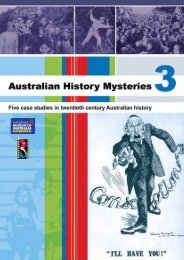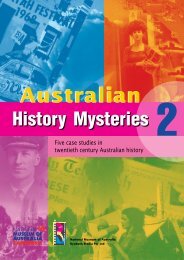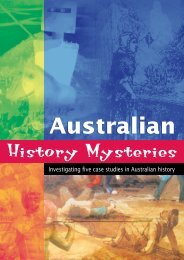Download Teacher Guide & Print Resources - Australian History ...
Download Teacher Guide & Print Resources - Australian History ...
Download Teacher Guide & Print Resources - Australian History ...
Create successful ePaper yourself
Turn your PDF publications into a flip-book with our unique Google optimized e-Paper software.
Activity page<br />
12C<br />
Source 7<br />
Bathurst was founded at the terminus of Cox’s Road on the<br />
orders of Governor Lachlan Macquarie who selected the<br />
site on 7 May 1815. It is the oldest inland town in Australia.<br />
The name Bathurst comes from the surname of the British<br />
Colonial Secretary Lord Bathurst. It was intended to be the<br />
administrative centre of the western plains of New South<br />
Wales, where orderly colonial settlement was planned. The<br />
settlers who crossed the Blue Mountains were harassed by<br />
Wiradjuri warriors, who killed or wounded stock-keepers<br />
and stock and were subjected to retaliatory killings. In<br />
response, Governor Brisbane proclaimed martial law on<br />
14 August 1824 to end ‘… the Slaughter of Black Women<br />
and Children, and unoffending White Men …’. It remained<br />
in force until 11 December 1824.<br />
http://en.wikipedia.org/wiki/Bathurst,_New_South_Wales andhttp://en.wikipedia.org/wiki/<strong>Australian</strong>_frontier_wars#New_South_Wales<br />
Source 8 Biography of Windradyne (c.1800–1829)<br />
Windradyne (c.1800–1829), Aboriginal resistance leader,<br />
also known as SATURDAY, was a northern Wiradjuri man of<br />
the upper Macquarie River region in central-western New<br />
South Wales. Emerging as a key protagonist in a period<br />
of Aboriginal-settler conflict later known as the ‘Bathurst<br />
Wars’, in December 1823 ‘Saturday’ was named as an<br />
instigator of clashes between Aborigines and settlers that<br />
culminated in the death of two convict stockmen at Kings<br />
Plains. He was arrested and imprisoned at Bathurst for one<br />
month; it was reported that six men and a severe beating<br />
with a musket were needed to secure him.<br />
After some of the most violent frontier incidents of the<br />
period, including the killing of seven stockmen in the<br />
Wyagdon Ranges north of Bathurst and the murder of<br />
Aboriginal women and children by settler–vigilantes near<br />
Raineville in May 1824, Governor Brisbane placed the<br />
western district under martial law on 14 August. The<br />
local military was increased to seventy-five troops, and<br />
magistrates were permitted to administer summary justice.<br />
Windradyne’s apparent involvement in the murder of<br />
European stockmen resulted in a reward of 200 hectares<br />
being offered for his capture. The crisis subsided quickly,<br />
although the failure to capture Windradyne delayed the<br />
repeal of martial law until 11 December. Two weeks later he<br />
and a large number of his people crossed the mountains to<br />
Parramatta to attend the annual feast there, where he was<br />
formally pardoned by Brisbane.<br />
The Sydney Gazette described Saturday as ‘without<br />
doubt, the most manly black native we have ever beheld<br />
… much stouter and more proportionable limbed’ than<br />
most Aborigines, with ‘a noble looking countenance, and<br />
piercing eye … calculated to impress the beholder’. Another<br />
observer thought him ‘a very fine figure, very muscular<br />
… a good model for the figure of Apollo’. His sobriety<br />
and affection for his family and kinsmen were considered<br />
remarkable.<br />
Apparently remaining camped in the domain at Parramatta<br />
for some time after the 1824 feast, Windradyne then<br />
returned to Bathurst. He declined to attend Governor<br />
Darling’s feast the following year. In later years, he was<br />
intermittently reported as being involved in raids on maize<br />
crops or in clashes with settlers around Lake George. In<br />
1828 an Aboriginal man being led to his execution for<br />
the murder of a stockman at Georges Plains attempted<br />
vainly to pin the crime on the ‘notorious Saturday’.<br />
Mortally wounded in a tribal fight on the Macquarie River,<br />
Windradyne died a few hours later on 21 March 1829 at<br />
Bathurst hospital, and was buried at Bathurst.<br />
Windradyne had been closely associated with George Suttor<br />
and his son William Henry, who were strong advocates on<br />
behalf of Aborigines during and after the period of martial<br />
law. Both lamented his passing in the Sydney press in<br />
April 1829. One of William Henry Suttor junior’s <strong>Australian</strong><br />
Stories Retold (1887) placed Windradyne at the scene of<br />
the Wyagdon attacks in May 1824 and described how his<br />
warriors had spared the life of the author’s father …<br />
In 1954 the Bathurst District Historical Society erected a<br />
monument beside a Wiradjuri burial mound at Brucedale,<br />
attaching a bronze plaque commemorating ‘The resting<br />
place of Windradene, alias ‘’Saturday”, last chief of the<br />
Aborigines: first a terror, but later a friend to the settlers….<br />
A true patriot’. His death date was erroneously given<br />
as 1835.<br />
In the late twentieth century Windradyne was transformed<br />
from a local figure to a character of national importance<br />
as a resistance hero. A suburb at Bathurst and a student<br />
accommodation village at Charles Sturt University, Wagga<br />
Wagga, were named after him. In May 2000 his presumed<br />
resting place was put under a voluntary conservation order,<br />
the occasion celebrated by Wiradjuri descendants and the<br />
Suttor family, continuing a 180-year-old friendship and<br />
creating a potent symbol of reconciliation.<br />
David Andrew Roberts, Online Dictionary of <strong>Australian</strong> Biography, http://adb.anu.edu.au/biography/windradyne-13251<br />
3 Add any information to your summary<br />
table on activity page 3A.<br />
4 Write a brief paragraph or do a comic<br />
strip sketch for your own history<br />
textbook (in box 8 of activity page 3C)<br />
to explain to readers what the main impacts<br />
of the crossing of the Blue Mountains were.<br />
The crossing of the<br />
Blue Mountains opened the<br />
west to an immediate rush of<br />
settlement. True or False?<br />
42<br />
Myths and Mysteries of the Crossing of the Blue Mountains


